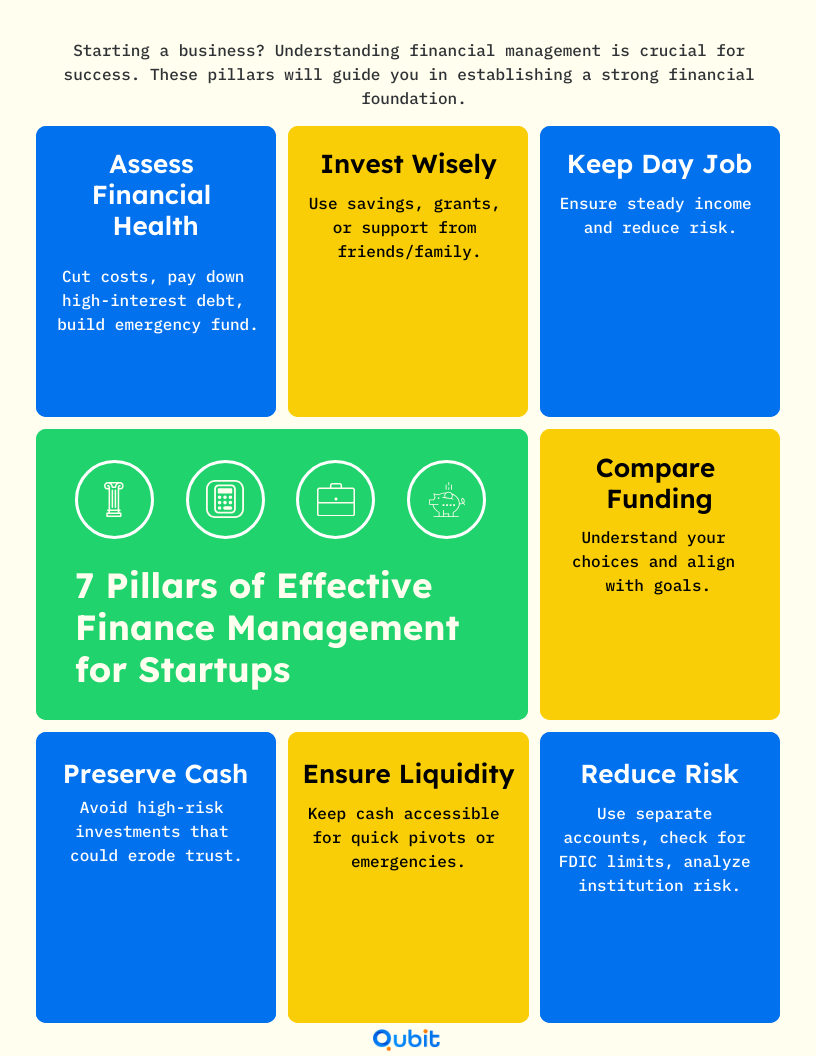Starting a business is an exciting venture, but managing finances effectively can be a daunting challenge for many entrepreneurs. Without a solid financial strategy, startups risk running into cash flow issues or missing growth opportunities.
Entrepreneur financial planning is not just about budgeting; it’s about creating a roadmap for sustainable success. Accurate financial forecasting for startups plays a critical role in helping startups make informed decisions and tackle uncertainties.

This guide delves into actionable strategies for startups to manage their finances effectively, covering topics like evaluating finances, securing funding, managing liquidity, and mitigating risks. Let’s jump right in.
Finance Management 101
1. Assess Your Financial Health and Plan Strategically
Start by reviewing your expenses. Find areas where you can cut costs. This helps you handle income ups and downs when you switch from a regular job to running your own business.
- Debt Management:
Check your current debts. Focus on paying off the ones with high interest. Consider consolidating or negotiating better repayment terms. - Emergency Fund:
Save three to six months of living expenses. This fund covers unexpected costs like medical bills or urgent repairs.
Planning your finances this way builds confidence. It sets a solid foundation for both personal and business success.
2. Invest Personal Funds in Your Startup
Many startups begin with a founder’s own investment. Using your personal savings, support from friends and family, or even grants can jumpstart your MVP. This not only funds your venture but also shows you believe in your idea.
- Personal Savings:
- Invest your own money.
- It signals confidence in your business.
- Friends & Family:
- Their support acts as a vote of confidence.
- It shows others trust your vision.
- Grants:
- Grants provide non-repayable funds.
- They ease financial strain without extra debt.
Understanding how personal funding impacts your startup’s financial health is equally important. Startup founders who grasp the essentials of financial statements for startup founders can better communicate their business’s financial health to stakeholders. This transparency not only builds trust but also sets the stage for future investment opportunities.
Personal funding is often the first step in turning an idea into reality. By carefully managing your resources and showcasing your dedication, you can create a solid foundation for your startup while positioning yourself for external funding opportunities.
3. Maintain Your Day Job While Prototyping
Keeping your day job while building your startup prototype can be a smart move. It gives you steady income while you work on your idea.
- Financial Stability:
- Your full-time job covers your bills.
- It lets you work on your prototype without rushing for revenue.
Use your spare time wisely. Even evenings and weekends can be perfect for research, testing concepts, or gathering feedback. This steady progress builds confidence in your idea.
- Incremental Progress:
- Validate market needs in small steps.
- Fine-tune your pitch deck bit by bit.
Staying employed also helps you plan your shift to full-time entrepreneurship. A steady paycheck means you can cover personal expenses and reinvest in your startup without stress.
- Planned Transition:
- Keep your income stream secure.
- Transition to entrepreneurship with a clear plan.
This approach minimizes risks and offers a safety net as you develop your business. It’s all about balancing growth with stability.
To better prepare for this transition, it’s essential to understand how to develop a financial roadmap for a startup, which aligns resources with goals and ensures a smoother shift into entrepreneurship. A well-thought-out balance between employment and prototyping not only reduces financial stress but also gives you the flexibility to pivot your business idea if necessary.
4. Explore and Compare Funding Opportunities
Securing funding is one of the most critical steps for startup founders after validating their ideas. The funding landscape offers a variety of options, including angel investors, incubators, accelerators, and venture capital firms. Each avenue presents unique benefits and challenges, making it essential for entrepreneurs to understand their choices and align them with their business goals.
Understanding the Funding Breakdown
PitchBook data reveals that seed funding dominates the pre-Series A stage, accounting for 82.7% of all funding deals. This trend underscores the importance of early-stage investments for startups aiming to scale. Grants make up 11.4%, followed by angel investments at 4.5%. Incubators and accelerators contribute 0.9%, while crowdfunding rounds out the list at 0.5%. These figures highlight the predominance of seed funding and its role in fostering innovation.
For startups seeking seed funding, the median deal size stands at $3.9 million, according to PitchBook statistics from 2020 to 2023. This amount reflects the typical financial support startups can expect during their early growth phases. Entrepreneurs should use this data to benchmark their funding goals and prepare compelling pitches that resonate with investors.
Platforms to Connect with Investors
Finding the right investors can be a daunting task, but platforms like Qubit Capital simplify the process. Utilizing such platforms can significantly enhance the visibility of your startup and streamline investor outreach.
The Role of Financial Models
Detailed financial models are indispensable for attracting investors. These models demonstrate the viability of your startup’s vision and provide a clear roadmap for growth. Investors often prioritize startups with well-structured financial plans that showcase potential profitability and scalability. For actionable insights, explore examples of financial models to attract investors, which can help refine your approach and increase your chances of securing funding.
Trends in Seed Funding
The dominance of seed funding reflects a heavy reliance on early-stage investments to fuel innovation and market entry. Over 80% of pre-Series A funding is attributed to seed rounds, emphasizing the importance of building strong relationships with seed investors. Entrepreneurs should focus on crafting compelling pitches and demonstrating market potential to capitalize on this trend.
Whether you’re exploring angel investments or preparing for venture capital rounds, understanding the funding landscape is crucial. By leveraging data and tools, founders can identify the most suitable funding opportunities and position their startups for success.
Safeguard Your Capital: Preserve Cash Effectively
Entrepreneurs often face a delicate balancing act between taking calculated operational risks and safeguarding their financial foundation. While investors understand that operational risks are inherent to business growth, risking cash reserves is a different matter entirely. Preserving capital is not just about protecting funds—it’s about maintaining trust and credibility with stakeholders.
Low-risk investments, while seemingly safe, often fail to deliver adequate returns to offset the potential consequences of losing principal. A diminished cash reserve can severely limit operational flexibility and future opportunities. More critically, a loss in principal can erode investor confidence, making it harder to secure funding for future growth.
Entrepreneurs must prioritize financial planning that ensures the preservation of cash reserves while still allowing room for strategic risks. For instance, creating a robust financial model lays the foundation for attracting investors and establishing credibility in startup finances, but that's only when you know how to create a financial model for investors.
Preserving cash reserves is not just a financial strategy—it’s a trust-building exercise. Investors expect entrepreneurs to manage operational risks responsibly while ensuring that the core financial foundation remains intact. This approach not only supports business continuity but also strengthens investor relationships, paving the way for sustainable growth.
Ensure Adequate Liquidity for Flexibility
Liquidity serves as the lifeline for startups, especially in unpredictable financial landscapes. Entrepreneurs must prioritize financial planning to ensure they can address unexpected expenses without disrupting operations. Locking funds into investments with withdrawal penalties, such as certain certificates of deposit (CDs), can severely limit cash flow during critical moments.
Instead, focus on assets that offer rapid access to cash. Instruments like high-yield savings accounts or money market funds provide liquidity while maintaining some level of growth potential. This approach enhances operational flexibility, allowing startups to pivot or respond to unforeseen challenges effectively.
Maintaining liquidity is not just about safeguarding against emergencies; it’s about empowering your business to seize opportunities as they arise. Thoughtful entrepreneur financial management ensures that startups remain agile, resilient, and ready to adapt in dynamic environments.
Optimize Costs and Minimize Hidden Fees
Hidden fees and high commissions can quietly drain your profits, leaving you with diminished returns. For entrepreneurs engaged in financial planning, understanding and managing these costs is critical to preserving resources and avoiding negative yields. Fees such as minimum balance charges or excessive transaction commissions often go unnoticed but can accumulate over time, significantly impacting your bottom line.
To minimize these expenses, start by scrutinizing all service agreements and fee structures associated with your financial tools. Opt for platforms and advisors offering transparent pricing models. Regular audits of your accounts can also help identify unnecessary charges, enabling you to take corrective action promptly.
Effective entrepreneurship financial planning requires vigilance and proactive cost management. By addressing hidden fees early, you can protect your investments and ensure your financial strategies yield positive results.
Assess and Mitigate Counterparty Risk
Understanding counterparty risk is essential for entrepreneurs aiming to safeguard their surplus cash. Evaluating the financial stability of institutions where funds are allocated is the first step toward effective risk management. This involves analyzing the institution’s creditworthiness, liquidity, and adherence to regulatory standards.
One practical approach to mitigating counterparty risk is the use of separate accounts tailored to specific needs. Entrepreneurs can allocate funds into distinct accounts for operational expenses and short-term investments, ensuring that risk exposure is minimized. This strategy also provides clarity in tracking cash flow and maintaining liquidity.
The CommonBond case serves as a compelling example of this approach. After raising its first funding round in November 2012, CommonBond implemented a dual-account strategy, dividing funds between operating expenses and short-dated investments. By staying within FDIC insurance limits, the company effectively reduced counterparty risk while maintaining financial flexibility.
Entrepreneur financial planning requires vigilance, and adopting proven strategies like these can safeguard your business’s financial health.
Conclusion
Achieving financial stability is crucial for startups aiming to thrive in competitive markets. By evaluating current finances, investing personal funds wisely, and maintaining employment during the prototyping phase, entrepreneurs can build a solid foundation. Exploring diverse funding options, preserving capital, ensuring liquidity, managing costs effectively, and mitigating counterparty risk are all essential strategies that contribute to sustainable growth.
Actionable financial management is not just a necessity—it’s a driving force behind startup success. Implementing these strategies with precision can help founders overcome challenges and seize opportunities.
If you’re ready to take your startup to the next level, we at Qubit Capital are here to help. For robust, investor-ready insights, explore our Financial Model Creation service. Let us help you develop precise projections and compelling financial models that boost investor confidence.
Key Takeaways
• Review and strategically address current financial health before embarking on full-time entrepreneurship.
• Investing personal funds is essential but must be balanced with sound risk management.
• Maintaining employment during prototyping is a practical risk mitigation strategy.
• Diverse funding options supplemented by robust financial models can drive startup growth.
• Capital preservation, liquidity, and cost management are critical pillars for long-term financial success.
Frequently asked Questions
What are the 4 C's of financial management?
• Cash: Manage your cash flow effectively.
• Credit: Secure favorable terms for credit lines.
• Cost: Control and minimize expenses.
• Capital: Preserve equity and ensure sufficient reserves.


 Back
Back



